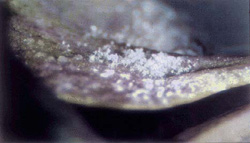Downy mildew of brassicas
Downy mildew is caused by a fungus-like organism (Hyaloperonospora parasitica) that mainly attacks foliage.
It's responsible for substantial losses in seedling production, especially in the cooler months. Young plants are more susceptible than older plants.
H. parasitica can infect cauliflower curds and produce systemic symptoms in heading brassicas and radish.
Host plants
H. parasitica infects a wide range of plants, including:
- broccoli
- brussels sprouts
- cauliflower
- cabbage
- chinese broccoli
- chinese cabbage
- chinese mustard
- kale
- kohlrabi
- radish
- turnip
- shepherd's purse
- swede
- watercress.
A different race of H. parasitica causes downy mildew on stocks (Matthiola incana). H. parasitica on brassicas will not infect stocks and vice versa.
Symptoms of downy mildew
The following symptoms can indicate downy mildew.

On seedlings:
- a fluffy or powdery-white mass of spores on the under surface of brassica seed leaves (cotyledons)
- followed by black speckling and puckering of the upper surface
- leaves prematurely yellow and fall from plants.
Symptoms on mature plants are generally confined to the leaves closest to the ground:
- Black speckling might be visible, which may later be surrounded by patches of yellow.
- If the infection becomes systemic, black to grey flecking or streaking may be present in the stems.
- On radish hypocotyls (edible fleshy root), black patches develop externally on the surface and a black discolouration or speckling is present internally.
- Cauliflower curds show blackening both externally and internally.
Controlling downy mildew
The best way to control this disease is by combining management practices with fungicide protocols.
To control downy mildew:
- use seed treated with hot water or seedlings raised from such treatment
- plant disease-free seedlings
- don't water seedlings in the morning (this is when spores are released)
- keep seedlings as dry as possible – one heavy watering is preferable to a long, light watering
- use a preventative fungicide spray program if weather conditions favour disease
- maintain a well-ventilated environment – a lower relative humidity minimises spore production. This may mean fewer plants and trays per square meter
- maintain a balanced nutrition program – deficiency of potash will increase the susceptibility of seedlings to downy mildew
- remove any source of spores, such as heavily infected trays of seedlings, old infected seedlings, and crucifer weeds
- disinfect glass houses and igloos and rotate areas housing seedlings
- plough in field crop debris immediately after harvest and use a crop rotation of 2 to 3 years, if possible
- alternate chemicals of different classes to avoid H. parasitica developing resistance to a particular group of fungicides.
Spread of disease
The powdery white spores are the major means of dispersal of H. parasitica, especially once it is established within seedlings crops.
Spores are produced overnight and released the following morning as the air dries out. They are dispersed by wind and rain splash.
Environmental conditions
The disease is favoured by cool temperatures with an optimum range of 8°C to 16°C. The vegetative spores need water to germinate and can infect seedlings within 3 hours of contact with a leaf.
Deficiencies of potash have been shown to increase the susceptibility of cauliflower seedlings to downy mildew.
Survival of Hyaloperonospora parasitica
Oospores (sexually produced or survival spores) of the H. parasitica are formed in ageing and dying leaves. They survive in debris in the soil from one crop to the next.
H. parasitica is known to survive on seed but this might not be the case in Australia. It can survive on volunteer and weedy brassicas. In seedling nurseries it often survives on old, slightly infected seedlings that have passed their 'use-by date'.
Reporting an unusual plant insect pest or disease
Report any unusual plant pest or disease immediately using our online reporting form or by calling the Exotic Plant Pest Hotline on 1800 084 881. Early reporting increases the chance of effective control and eradication.
Please take multiple good quality photos of the pests or damage to include in your report where possible, as this is essential for rapid pest and disease diagnosis and response.
Your report will be responded to by an experienced staff member, who may seek more information about the detection and explain next steps.
Report onlineReferences
Commonwealth Agriculture Bureau International. Hyaloperonospora parasitica (downy mildew) datasheet. Crop Protection Compendium. Last accessed 6 April 2020.
Koike ST, Gladders P, Paulus AO (2007) Vegetable Diseases, A colour handbook. Manson Publishing 448pp.
Persley D, Cooke T, House S (2010) Diseases of vegetable crops in Australia. CSIRO Publishing 292pp.